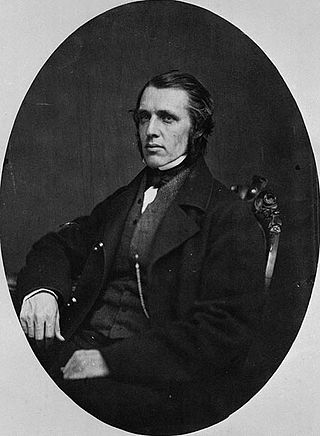
Victoria University is a federated university, which forms part of the wider University of Toronto. The school was founded in 1836 by the Wesleyan Methodist Church of Canada as a nonsectarian literary institution. From 1841 to 1890, Victoria operated as an independent degree-granting university, before federating with the University of Toronto in 1890, relocating from Cobourg to Toronto.

William McDougall was a Canadian lawyer, politician, and one of the Fathers of Confederation.

Cobourg is a town in the Canadian province of Ontario, located in Southern Ontario 95 km (59 mi) east of Toronto and 62 km (39 mi) east of Oshawa. It is the largest town in and seat of Northumberland County. Its nearest neighbour is Port Hope, 7 km (4 mi) to the west. It is located along Highway 401 and the former Highway 2. To the south, Cobourg borders Lake Ontario. To the north, east and west, it is surrounded by Hamilton Township.
Thomas McKay was a Canadian businessman who was one of the founders of the city of Ottawa, Ontario.

The Notre-Dame Cathedral Basilica is a Roman Catholic minor basilica in Ottawa, Ontario, Canada located on 385 Sussex Drive in the Lower Town neighbourhood. It was designated a National Historic Site of Canada in 1990.

Robert O'Hara Burke was an Irish soldier and police officer who achieved fame as an Australian explorer. He was the leader of the ill-fated Burke and Wills expedition, which was the first expedition to cross Australia from south to north, finding a route across the continent from the settled areas of Victoria to the Gulf of Carpentaria. The expedition party was well equipped, but Burke was not experienced in bushcraft. A Commission of Inquiry held by the Government of Victoria to investigate the failure of the expedition was a censure of Burke's judgement.

Michael Power was the first Roman Catholic Bishop of Toronto.
The Midland Railway of Canada was a historical Canadian railway which ran from Port Hope, Ontario to Midland on Georgian Bay. The line was originally intended to run to Peterborough, but the competing Cobourg and Peterborough Railway was completed in 1854 and the owner's plans changed. Redirecting the line northward, it opened as the Port Hope, Lindsay & Beaverton Railway, a much longer line than originally planned. A further expansion launched in 1869 pushed the line westward towards Georgian Bay, and prompted renaming as the Midland Railway.

Adam White was a Scottish zoologist.
Ralph Neville-Grenville DL, JP was a British Conservative Party politician.
Fitzhenry is an Irish Hiberno-Norman surname. It is patronymic as the prefix Fitz- derives from the Latin filius, meaning "son of". Its variants include the alternate forms "Fitz-Henry", FitzHenry and ‘’Fitz Henry’’, and the given name turned surname Henry. Another Irish variant is Fitzharris, and the surnames were often used interchangeably within the same family. Fitzhenry is rare as a given name, but may indicate that the person was descended from a female Fitz(-)henry, or that the person's father had Henry as a first forename.

Théophile-Abraham Hamel was a Canadian artist who painted mainly portraits and religious images in 19th-century Quebec.

The Buckland River, a perennial river of the North-East Murray catchment of the Murray-Darling basin, is located in the Alpine region of Victoria, Australia. It flows from the eastern slopes of the Buffalo Range in the Australian Alps, joining with the Ovens River at Porepunkah.
Warren Heywood Williams was an American architect, who spent most of his career working in the U.S. state of Oregon. Starting in 1860, he apprenticed in San Francisco as a draftsman at the architectural firm of his father, Stephen H. Williams, and Henry W. Cleaveland. Warren Heywood Williams and his wife, Christina, had two sons who became architects, Warren Franklin Williams and David Lochead Williams.

William James Browne,, generally referred to as Dr. Browne, was a grazier and pastoralist in South Australia who was born and died in England. His brother, John Harris Browne, was a noted explorer and pastoralist in the same colony.
George Morss Jukes Boswell, QC, was a lawyer and judge in Canada West, Province of Canada. Born in England of Scottish descent, his family emigrated to Upper Canada in 1822. He was married twice, with thirteen children.
















